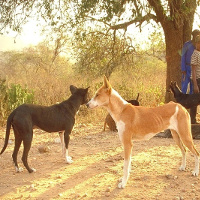Appearance of the Africanis
|
| Although there is great variation from dog to dog within the Africanis breed, a comprehensive breed standard has been established by the Africanis Society. Africanis are fairly large dogs, usually measuring between 50 and 60 centimeters at the withers, and weighing between 15 and 30 kilos. They tend to be athletic but slender, with the ribs barely visible in a healthy Africanis. It has long, slender legs and tends to be slightly longer than it is tall. Its head is wedge-shaped and streamlined, like that of ancient greyhounds, and its muzzle is long and conical. Africanis' oval eyes can be any color, although there are recommendations against breeding these rare dogs with blue or bi-color eyes, and their medium-sized, V-shaped ears can be worn straight, semi-straight or floppy. Medium-sized, V-shaped ears can be carried erect, semi-erect or floppy. Its short, easy-care coat is double-layered and can be any color or combination of colors. |
Temperament of the Africanis
|
| These dogs developed alongside man rather than being developed by man, and their temperament reflects this. Although they are generally exceptionally friendly and patient with people of all ages, they still need space and are sometimes uncomfortable with an abundance of physical contact, and if pushed, can sometimes become reactive. Although all interactions between dogs and children need to be supervised, Africanis dogs are particularly patient and playful with children and can generally be trusted to be gentle. They tend to be friendly with other dogs and, although they are vigilant and will alert you to any encroachment, they are not usually aggressive unless their family is directly threatened. These dogs are independent thinkers capable of finding creative solutions to their problems and, if not sufficiently mentally stimulated, can invent problems, such as how to get to the steak you had planned for dinner. Fortunately, they are also highly intelligent and eager to please, so can be easily trained when positive training methods are used. |
Needs and activities of the Africanis
|
| Africanis have great stamina and energy, and generally need at least an hour to an hour and a half of vigorous exercise a day. Although long walks and hikes are appreciated, these dogs are happiest if they have frequent opportunities to stretch their legs and run. Activities like rally sports or acrobatic dancing suit them well, and although skijoring is a little too cold for these warm-climate dogs, a high-intensity activity like bike-jor can help them burn off some of their energy. These dogs can adapt to an apartment-type environment if given enough extra exercise, but they are generally happiest with more space. |
Maintenance of the Africanis
|
| These dogs have developed a natural resistance to many internal and external parasites and should generally only be bathed when necessary, as over-frequent bathing can strip the natural oils from the dog's coat, making it more susceptible to environmental hazards. Brush this dog every week or so with a slicker or soft bristle brush, or wipe with a damp washcloth, to remove loose hair and maintain a healthy, shiny coat. Africanis ears should be checked regularly to ensure they are clean, dry and free from debris or infection. |







 English (United Kingdom)
English (United Kingdom)